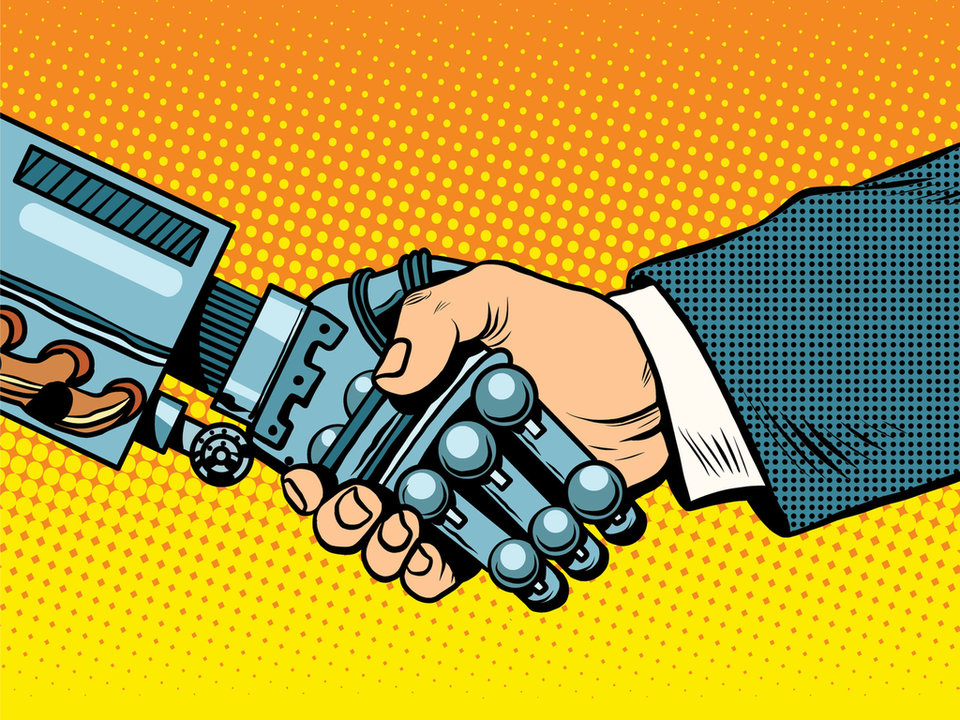Insight
Will I have a job?
AI and the future of work
AI expert and author Professor David Shrier explores what artificial intelligence means for the future of work and how businesses can prepare for it.
Artificial intelligence (AI) has been slowly seeping into the workplace over the past ten years, with increasingly profound impacts. We may not be fully aware of it as we use it, but AI has been showing up with ever-greater frequency.
That novel background you are using on Zoom for your video call while you work from home under Covid-19 restrictions? That’s AI. The spam and cybersecurity filters on your email? More AI. Siri helping you search for something online? AI again.
As convenient as these innovations are, they are fundamentally trivial when compared to the ability of AI to automate more and more complex human tasks. A chapter in my most recent book about AI, Augmenting Your Career: How to Win at Work in the Age of AI, was partially written by an AI.
How is AI showing up in core workplace activities? Where is it headed? And most importantly, what can we do about it?
AI moves up the career ladder
In numerous industries representing a substantial portion of the global economy, from financial services to healthcare, artificial intelligence is taking on ever-greater portions of the workload. While it might have begun with lower-skill tasks, such as replacing human transcribers for doctor’s offices with speech-to-text dictation systems, we are increasingly seeing AI show up in more complex work.
For example, the work at investment banks, at the lower levels, consists of constructing financial models about companies, and generating PowerPoint documents that describe the businesses. Historically, this work has been conducted by junior analysts and associates who stay up late hours, grinding away at manually producing material. New AI systems can produce models in seconds, and even the presentation materials to showcase them, making an army of junior professionals redundant.
AI algorithms are now automating decision-making around medical insurance approvals, bringing efficiencies to the multi-trillion-dollar US healthcare market – while raising troubling questions about the ethics of medical care.
What does a world look like when machines are doing almost everything? What role is there for humanity?
The future may arrive faster than many people expect, driven by the accelerating pace of AI systems’ evolution, and with it startling and disconcerting applications of AI. Many human tasks other than those in the services industries (like those performed by restaurant workers, or nursing professionals) could be automatable within five or ten years – not 30 or 40 years.
From project management to writing and publishing, nearly all activities that a human can do, an AI will be able to do – but with much greater speed and alacrity. The question will no longer be “What can AI do?” but instead “How much will we allow AI to do?”
The lure of greater profits through mass layoffs may prove impossible for many companies to resist, and with it we will see the potential for civil discontent over AI automation of human tasks. The corporate chieftains at the World Economic Forum in Davos were whispering of 99% unemployment. What does a world look like when machines are doing almost everything? What role is there for humanity?

How business leaders can prepare now
We will need to navigate these questions in the next few years, both in society at large and also in the workplace. And the transition period will be messy.
The important fact to remember is that AI is a human-created technology, and we can make decisions about how it gets used. At a structural level, we can decide on what parameters surround the adoption of AI – whether that shows up as a set of guidelines and policies in the workplace around where and how AI is used, or at the legislative level around how countries accept or reject aspects of AI, and navigate the complex set of issues around its widespread use.
Indeed, the European Parliament and European Commission have generated a body of thought around what AI should look like in society, and are moving towards adopting formal legislation to codify thinking.
The next decade holds tremendous opportunity for those who are aware and alert to the possibilities of AI – and are proficient in what to do with it.
Business leaders can do more than simply craft a policy. The most important first step leaders can take is improving the AI literacy of their teams. Everyone from Facebook to mainstream banks have been burned by misapplication of AI, whether that be the rise of fake news or inadvertent violation of lending laws due to AI decision-making.
A better-educated workforce will be better equipped to identify and remediate potential risks from these AI systems. Beyond that, workers need to be reskilled into more creative and higher-value professions, as the lower-level work gets automated by AI.
Employers need to invest in this reskilling for a host of reasons, not the least of which is preserving the culture of their organisations. It’s better to take someone who already fits into your environment and orient them in a new direction, than take on the risk of a new hire of uncertain provenance.
This doesn’t mean turning people into AI programmers – indeed, most AIs will soon be programmed by other AIs. It means helping people understand how to ‘hybridise’ with AI, to collaborate effectively with it to unlock new potential revenue and growth.
The next decade holds tremendous opportunity for those who are aware and alert to the possibilities of AI – and are proficient in what to do with it. The urgency of the need for immediate action has never been greater, and the potential benefits commensurately large.

David L. Shrier is Professor of Practice, AI and Innovation at Imperial College Business School, and the co-founder and CEO of Esme Learning. His latest book, Augmenting Your Career: How to Win at Work in the Age of AI, was published in June 2021.